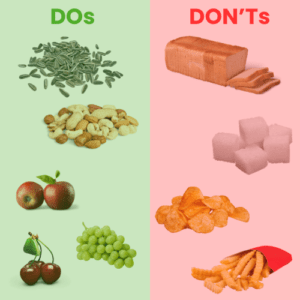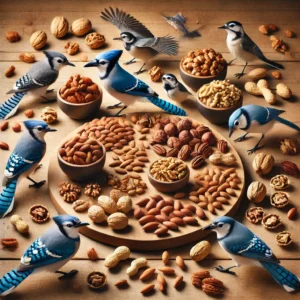If you’ve ever caught a glimpse of a bold, blue bird darting toward your feeder, chances are it was a Blue Jay. Known for their striking plumage and clever behavior, Blue Jays are common guests in backyards across eastern and central North America. But if you’re asking yourself what do Blue Jays eat, or more specifically what do Blue Jays like to eat at your feeders compared to other birds, you’re not alone.
Blue Jays (Cyanocitta cristata) have one of the most varied diets of any backyard bird. According to the Audubon Society, their diet is approximately 75% plant-based and 25% animal-based, depending on the season. Whether you’re hoping to attract these vocal beauties or simply understand how they affect the dynamics at your feeders, knowing their dietary preferences is essential.
Let’s explore the seasonal eating habits, natural foraging behaviors, and favorite feeder foods of Blue Jays—backed by expert studies and perfect for backyard birders.

What Do Blue Jays Like to Eat at Bird Feeders?
Blue Jays are confident feeder birds, often arriving in pairs or small groups and quickly dominating the space. Based on my personal observations and supported by research from The Wilson Bulletin and field studies from the Audubon Society—which notes that up to 75% of their diet consists of vegetable matter like acorns, seeds, berries, and grains—Blue Jays have clear preferences when it comes to feeder offerings:
Peanuts (especially in the shell, unsalted)
Black oil sunflower seeds
Suet cakes in colder months
Cracked corn and chunky seeds
Tree nuts such as acorns, hazelnuts, or almonds

Due to their larger size, Blue Jays favor platform feeders, hopper-style feeders, or flat surfaces over hanging tube feeders with small perches.
In a behavioral study by Waite (1992), Blue Jays were observed weighing peanuts in their beaks—literally shaking them to judge which ones were full. If your peanut wreath disappears quickly, it’s probably a jay caching peanuts for later. So expect to find stashed peanuts in your flowerpots or under bushes.
Blue Jay Diet by Season: What They Eat Throughout the Year
Blue Jays are highly adaptable birds, and their diet reflects their resourcefulness. Depending on the time of year, they shift from hunting insects to collecting nuts, adjusting their eating habits based on what’s most accessible and energy-rich in each season. This flexibility not only helps them survive in varied climates but also explains why they’re such successful backyard visitors year-round.
Spring & Summer
In warmer months, Blue Jays turn to insects for energy and to feed their young. A U.S. Forest Service study (Tarvin & Woolfenden, 1999) found that around 22% of their diet comes from animal matter like.
Beetles
Caterpillars
Grasshoppers
Spiders
Wasp larvae
This protein-rich diet supports nestlings and adults during the molting season.

Fall
Autumn is all about nuts. Blue Jays are often seen collecting:
Acorns
Beechnuts
Hickory nuts
According to Johnson & Adkisson (1985), a Blue Jay can carry as many as five acorns at once using its bill and expandable throat pouch. This behavior, known as caching, helps them prepare for winter and even contributes to forest regeneration.
Winter
When temperatures drop and insects are scarce, Blue Jays rely heavily on what they stored earlier in the year. Their winter diet—more than 75% plant-based—includes:
Cached acorns and other nuts
Peanuts
Sunflower seeds
High-fat suet
What Do Blue Jay Birds Eat Naturally in Backyards?
Even without a feeder, Blue Jays are savvy foragers. They’ll hunt and gather from a range of natural food sources including:
Acorns and other nuts
Wild fruits and berries (dogwood, serviceberry, cherries, grapes)
Insects and spiders
Occasionally small vertebrates, such as frogs, small rodents, or baby birds (though Laskey, 1944, notes this is under 1% of their total diet)
In suburban settings, they may also raid vegetable gardens or snack on fruit trees.

Feeding Habits and Clever Behaviors
Blue Jays aren’t just noisy—they’re some of the most clever birds at your feeder. Here’s what sets them apart:
Caching Food:
In the fall, they stash thousands of acorns and seeds in trees, under leaves, or in the ground. Studies (Darley-Hill & Johnson, 1981) have shown this behavior plays a role in spreading oak trees.
Tool-Like Feeding Techniques:
Blue Jays often hold tough foods in their feet and use their beaks to hammer them open—something not many songbirds do.
Feeder Takeover Tactics:
They’ll sometimes mimic hawk calls (Baylis, 1982) to scare off other birds from the feeder. Jays use sound as a strategy, not just a call.
Team Foraging:
Blue Jays are social and often travel in family groups. One may stand guard while others eat, or signal danger with a loud “jay-jay” call.
What Do Baby Blue Jays Eat?
If you’ve spotted a Blue Jay nest or seen adults foraging nonstop in spring, it’s because baby jays need a lot of protein. Tarvin & Woolfenden (1999) note that nestlings are fed a steady diet of:
Caterpillars
Soft insects
Wasp larvae
Occasionally spiders or other soft-bodied animals
Both parents take part in feeding, and protein is critical for the growth and feather development of the chicks.

Regional Variations in the Blue Jay Diet
While the core of a Blue Jay’s diet is the same across North America, regional food availability influences their menu:
In the Northeast and Midwest, they rely heavily on acorns
In the Southeast, they may eat pecans or citrus fruits
In agricultural areas, corn and wheat become common forage items
Regardless of where they live, they follow the same seasonal pattern—protein in the spring, nuts and seeds in the fall and winter.
Final Thoughts: What Do Blue Jays Eat?
So, what do Blue Jays eat? The answer: nearly everything. From protein-packed insects in spring to cached acorns in winter, Blue Jays have one of the most flexible and fascinating diets of any backyard bird.
Whether you’re a seasoned birder or just starting to explore the hobby, offering Blue Jay-friendly foods can bring color, character, and curiosity to your backyard. Their intelligence, social behaviors, and striking presence make them a rewarding species to observe.
And don’t forget: those acorns they bury and forget? They just might grow into the trees your future birds will call home.
Sources
- Tarvin, K. A., & Woolfenden, G. E. (1999). Blue Jay (Cyanocitta cristata), The Birds of North America.
- Johnson, W. C., & Adkisson, C. S. (1985). Dispersal of beech nuts by Blue Jays. Oecologia.
- Waite, T. A. (1992). Social hoarding and dominance in captive Blue Jays. Animal Behaviour.
- Laskey, A. R. (1944). A study of nesting Blue Jays. Wilson Bulletin.
- Darley-Hill, S., & Johnson, W. C. (1981). Acorn dispersal by Blue Jays. Oecologia.
- Baylis, J. R. (1982). Avian mimicry: the mimicry of hawk calls by Blue Jays. Wilson Bulletin.




